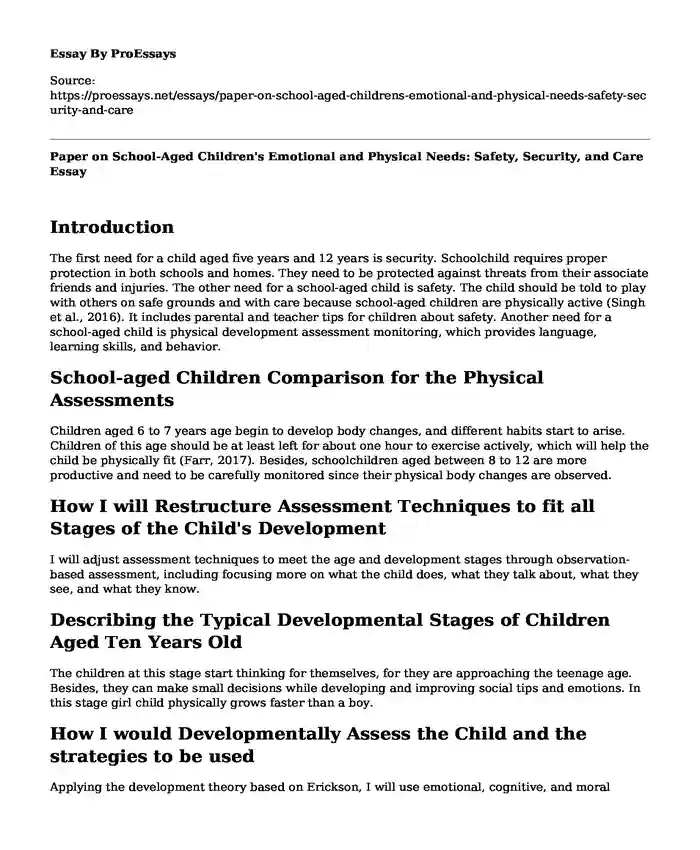Introduction
The first need for a child aged five years and 12 years is security. Schoolchild requires proper protection in both schools and homes. They need to be protected against threats from their associate friends and injuries. The other need for a school-aged child is safety. The child should be told to play with others on safe grounds and with care because school-aged children are physically active (Singh et al., 2016). It includes parental and teacher tips for children about safety. Another need for a school-aged child is physical development assessment monitoring, which provides language, learning skills, and behavior.
School-aged Children Comparison for the Physical Assessments
Children aged 6 to 7 years age begin to develop body changes, and different habits start to arise. Children of this age should be at least left for about one hour to exercise actively, which will help the child be physically fit (Farr, 2017). Besides, schoolchildren aged between 8 to 12 are more productive and need to be carefully monitored since their physical body changes are observed.
How I will Restructure Assessment Techniques to fit all Stages of the Child's Development
I will adjust assessment techniques to meet the age and development stages through observation-based assessment, including focusing more on what the child does, what they talk about, what they see, and what they know.
Describing the Typical Developmental Stages of Children Aged Ten Years Old
The children at this stage start thinking for themselves, for they are approaching the teenage age. Besides, they can make small decisions while developing and improving social tips and emotions. In this stage girl child physically grows faster than a boy.
How I would Developmentally Assess the Child and the strategies to be used
Applying the development theory based on Erickson, I will use emotional, cognitive, and moral techniques for child development evaluation (Wong et al., 2016). A sensitive technique is essential because it improves learning and enables the parent to have the ability to gather information from the child. Besides, the strategies that I will use to gain cooperation and potential findings include cognitive, and moral facts, and opinions and allow privacy that the child intact with other children.
References
Farr, R. H. (2017). Does parental sexual orientation matter? A longitudinal follow-up of adoptive families with school-age children. Developmental Psychology, 53(2), 252.
Singh, A., Squires, J., Yeh, C. J., Heo, K. H., & Bian, H. (2016). Validity and reliability of the developmental assessment screening scale. Journal of family medicine and primary care, 5(1), 124.
Wong, H. S., Santhakumaran, S., Cowan, F. M., Modi, N., & Medicines for Neonates Investigator Group. (2016). Developmental assessments in preterm children: a meta-analysis. Pediatrics, 138(2), e20160251.
Cite this page
Paper on School-Aged Children's Emotional and Physical Needs: Safety, Security, and Care. (2023, Nov 19). Retrieved from https://proessays.net/essays/paper-on-school-aged-childrens-emotional-and-physical-needs-safety-security-and-care
If you are the original author of this essay and no longer wish to have it published on the ProEssays website, please click below to request its removal:
- Learning and Your Life, Essentials of Student Success by Robert S. Feldman Essay
- Essay Sample on Public Schools: Houston's Decentralization & Centralization
- Paper Example on COVID-19 Impact on Schools: An Overview
- Essay on Developing Children: Maximizing Their Potential Through Learning
- Essay Example on How the Plot of a Short Story Influences its Popularity
- Admission Essay Sample on MBA Course in Robotics & Automation
- Critical Thinking Controversial Images Example







